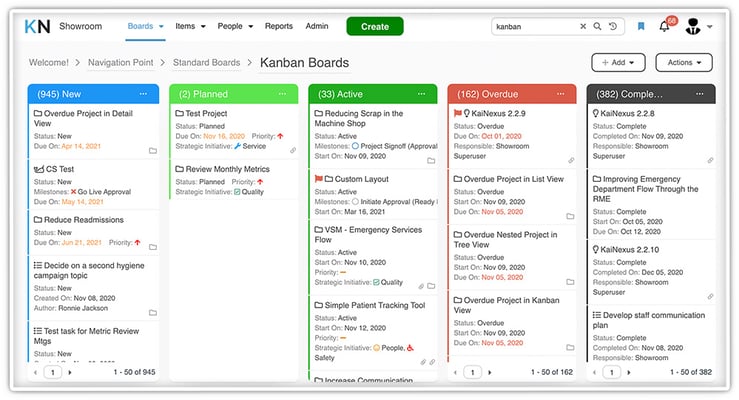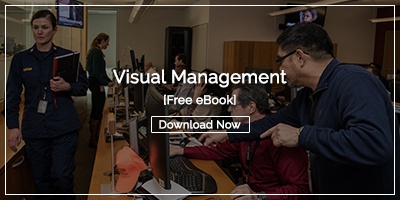 Continuous improvement is an ongoing effort to enhance processes, products, services, and overall business performance. It is a systematic approach focusing on making incremental, positive changes to achieve better results over time.
Continuous improvement is an ongoing effort to enhance processes, products, services, and overall business performance. It is a systematic approach focusing on making incremental, positive changes to achieve better results over time.
Continuous improvement drives business growth, fosters innovation, engages employees, satisfies customers, and mitigates risks. It is essential to achieving long-term success in today's competitive business environment.
For this reason, organizations and business thought leaders have developed many tools and techniques to support daily, incremental change. This article highlights some of the most popular and valuable continuous improvement methods.
What is continuous improvement?
Continuous improvement focuses on identifying and eliminating inefficiencies and bottlenecks in business processes. Businesses can streamline operations, reduce waste, and enhance productivity by continuously optimizing workflows and procedures. This leads to cost savings, improved resource utilization, and increased profitability.
In today's rapidly evolving business landscape, organizations must continually adapt and innovate to stay ahead of the competition. Implementing continuous improvement allows businesses to identify growth opportunities, respond to changing market trends, and deliver better products or services. By continuously enhancing their offerings, companies can attract and retain customers, gain a bigger competitive edge, and thrive in dynamic markets.
The continuous improvement model focuses on meeting and exceeding customer expectations. Businesses can enhance the quality and relevance of their offerings by continuously assessing customer feedback, monitoring market trends, and incorporating customer needs into product/service development. Satisfied customers are more likely to become repeat customers, recommend the business to others, and contribute to its long-term success.
Continuous improvement tools and techniques
The fundamental principles underlying continuous improvement include employee involvement, data-driven decision-making, a focus on customer needs, and a commitment to innovation and learning. These tools and techniques are designed to create the conditions under which positive change is the standard operating procedure. Often, continuous improvement software is used to manage and measure the impact of these improvement methodologies.
Kaizen
Kaizen is a Japanese term that translates to "change for the better" or "continuous improvement." It is a concept and philosophy that focuses on improving all aspects of life, including business processes, products, services, and personal development.
Kaizen gained popularity after World War II when Japanese industries, such as Toyota, implemented this approach to enhance their manufacturing processes. It emphasizes a culture of ongoing improvement, involving all employees, from top management to frontline workers, in pursuing excellence.
Gemba
Gemba is another Japanese term. It means "the actual place" or "the real place." In a business context, Gemba refers to the physical location where work is performed, such as the shop floor, factory floor, office, or any other operational area where value is created.
The concept of gemba is closely associated with the philosophy of Lean manufacturing and continuous improvement. It emphasizes the importance of going to the location where work is happening to gain firsthand knowledge, observe processes, identify issues, and make informed decisions.
Standard work
Standard work refers to a documented and agreed-upon set of instructions or procedures defining the most efficient and effective way to carry out a particular task or process. It serves as a reference and guideline for employees to ensure consistency, quality, and productivity.
5S
5S is a workplace organization methodology that originated in Japan. It focuses on creating a clean, organized, efficient work environment to improve safety, productivity, and efficiency. The name "5S" refers to five Japanese terms, each starting with the letter "S," that represent specific steps in the methodology:
- Sort (Seiri)
- Set in Order (Seiton)
- Shine (Seis)
- Standardize (Seiketsu)
- Sustain (Shitsuke)
Loss & waste analysis
Loss and waste analysis, also known as waste analysis or identification, is a systematic process of identifying and evaluating various types of losses and wastes within a business or operational context. It aims to uncover inefficiencies, bottlenecks, and non-value-added activities that impact productivity, quality, and overall performance.
The purpose of loss & waste analysis is to: identify waste, quantify the impact, prioritize improvement opportunities, and drive continuous improvement.
DMAIC
DMAIC is an acronym that stands for Define, Measure, Analyze, Improve, and Control. It is a structured problem-solving methodology used in process improvement and quality management. DMAIC is commonly associated with the Six Sigma approach, which aims to reduce defects, variation, and waste in business processes. Many organizations use software to support the DMAIC method.
Define: In this phase, the project goals, scope, and customer requirements are clearly defined. The focus is on understanding the problem or opportunity for improvement and establishing specific objectives.
Measure: The second phase involves gathering data and establishing a baseline of the current process performance. Key metrics are identified and measured to quantify the extent of the problem or improvement opportunity.
Analyze: In the analysis phase; the collected data is analyzed to identify the root causes of problems or areas of underperformance. Various tools and techniques, including statistical analysis, process mapping, cause-and-effect diagrams, and hypothesis testing, may be used to uncover the underlying factors contributing to the issues.
Improve: This phase focuses on generating and implementing solutions to address the identified root causes. Potential improvement ideas are generated, evaluated, and prioritized based on their potential impact and feasibility. Experiments or pilot tests may be conducted to validate the effectiveness of the proposed solutions.
Control: The final phase aims to sustain improvements and ensure long-term success. Control measures and monitoring systems are put in place to track the performance of the improved process and prevent regression.
PDCA
PDCA is an acronym for Plan, Do, Check, and Act, which represents a continuous improvement cycle widely used in quality management and process improvement. Also known as the Deming Cycle or Shewhart Cycle, PDCA provides a systematic framework for problem-solving, decision-making, and implementing improvements.
Plan: The problem or objective is clearly defined in the planning phase, and goals and strategies are established. This involves gathering information, analyzing data, and identifying improvement opportunities.
Do: The second phase involves implementing the plan developed in the previous step. It includes implementing the proposed changes or improvements on a small scale or in a controlled environment. Data is collected during the implementation phase to monitor the effects of the changes and gather insights for further analysis.
Check: The checking phase evaluates the results and compares them against the established objectives and targets. Data collected in the "Do" phase is analyzed to assess the effectiveness of the changes and measure the progress made.
Act: Based on the results and analysis from the previous phases, the acting phase involves taking appropriate actions to either standardize and sustain the improvements or refine the approach if necessary. If the desired results have been achieved, the changes are documented, standardized, and integrated into the normal processes.
A3
In a business context, an A3 refers to a problem-solving and communication tool typically presented on a single sheet of paper of the A3 size (11x17 inches or similar). The A3 process is derived from the Lean methodology and is widely used for collaborative problem-solving, decision-making, and project management.
The A3 methodology encourages a concise and structured approach to problem-solving and communication by following these key steps:
Background: The A3 begins with a clear description of the current situation, including the problem or opportunity for improvement, relevant data, and any contextual information necessary to understand the issue.
Goal: The desired outcome or goal is stated in a measurable and specific manner. This sets the direction for the problem-solving process and provides a reference point for evaluating success.
Analysis: This section involves conducting a thorough examination of the problem or situation. It includes gathering and analyzing data, identifying root causes, and using tools such as process maps, fishbone diagrams, or Pareto charts to gain insights into the underlying factors contributing to the problem.
Countermeasures: Based on the analysis, potential countermeasures or solutions are proposed. These are actions or changes to address the root causes and achieve the desired outcome. The countermeasures should be practical, actionable, and aligned with the overall goal.
Action Plan: This step involves developing a detailed plan for implementing the selected countermeasures. It includes defining the specific actions, assigning responsibilities, establishing timelines, and outlining necessary resources or support for successful execution.
Follow-up and Results: Once the countermeasures are implemented, the A3 process emphasizes the importance of monitoring and evaluating the results. This involves measuring the impact of the changes, comparing them against the initial goal, and assessing the effectiveness of the implemented solutions. Lessons learned and insights gained are documented for future reference.
5 Whys
The 5 Whys is a popular technique used to explore the root causes of a problem or issue by repeatedly asking "Why?" until the underlying cause is identified. It is a simple yet effective problem-solving approach that helps uncover more profound layers of causation beyond the initial symptoms or surface-level explanations.
The process of using the 5 Whys involves the following steps:
Define the problem: Clearly articulate the problem or issue that needs to be addressed. This helps focus the investigation on a specific area of concern.
Ask "Why?" for the first time: Start by asking why the problem occurred or why the issue is happening. This question aims to identify the immediate cause or event that led to the problem.
Repeat the process: For each answer generated in step 2, ask "Why?" again to delve deeper into the underlying causes. Repeat this process for each response, asking "Why?" about the previous answer.
Reach the root cause: Continue asking "Why?" until you reach a point where the answer provides a root cause or a fundamental reason for the problem. The root cause is typically a systemic issue or process failure that, when addressed, can prevent the problem from recurring.
Fishbone diagram
A fishbone diagram also called a cause-and-effect diagram or Ishikawa diagram, is one of several Lean tools used to explore and analyze the potential causes of a problem or an effect. It helps identify and categorize the various factors that contribute to the occurrence of a specific issue or outcome.
The fishbone diagram gets its name from its shape, which resembles the skeleton of a fish. It consists of a horizontal line representing the effect or problem being investigated, with several slanting lines protruding from it like the bones of a fish. Each slanting line represents a category of potential causes, and smaller lines extend from these categories to represent specific factors or causes within each category.
Kanban
Kanban is a visual management tool and methodology from the Toyota Production System (TPS) and has been widely adopted in various industries and fields. It improves workflow efficiency, optimizes resource allocation, and enhances overall productivity.
The word "kanban" in Japanese translates to "visual card" or "signboard." The core principle of kanban is to visualize work and workflow, allowing teams to clearly understand their tasks, priorities, and progress. It helps teams visualize the flow of work from start to finish, making it easier to identify bottlenecks, manage capacity, and maintain a smooth and continuous workflow.

Visual management
Visual management is a practice that involves using visual tools, cues, and displays to enhance communication, understanding, and decision-making within an organization. It utilizes visual representations to convey information, monitor progress, and provide a clear and concise overview of key aspects of operations.
Visual management aims to make important information easily accessible, understandable, and actionable to individuals at all levels of the organization. Some common examples of visual management tools and techniques include:
Visual Boards: These are physical or digital boards that visually represent information, such as project status, task assignments, performance metrics, or key performance indicators (KPIs). Visual boards provide a centralized location for team members to track progress, identify bottlenecks, and align their efforts.
Kanban Boards: Kanban boards visually represent the flow of work and tasks using columns and cards. They help teams visualize their workflow, track the status of work items, and manage their workload effectively.
Andon Boards: Commonly used in manufacturing, onboard displays real-time information about production status, equipment performance, and quality issues. They provide a visual signal when problems occur, enabling swift responses and corrective actions.
Process mapping
Process mapping, also known as process flowcharting or process diagramming, is a visual representation technique used to depict and analyze the sequence of steps, activities, and interactions involved in a process. It provides a clear and structured overview of how an existing process functions, enabling better understanding, analysis, and improvement of process management.
Value stream mapping
Value stream mapping is a Lean management technique used to analyze and visualize the flow of materials, information, and activities required to deliver a product or service to customers. It provides a comprehensive overview of the entire value stream, highlighting value-adding and non-value-adding activities. The purpose of value stream mapping is to identify and eliminate waste, reduce lead times, and improve overall process efficiency.
What are the benefits of continuous improvement tools?
These tools and techniques have become widespread because their reliability yields several significant benefits that organizations of all types, from manufacturing to healthcare, can enjoy.
Increased operational efficiency
Continuous improvement plays a crucial role in increasing operational efficiency within an organization. By focusing on incremental and ongoing enhancements, continuous improvement optimizes processes, eliminates waste, and enhances overall performance.
Organizations can identify non-value-adding activities, bottlenecks, and inefficiencies by closely examining processes and value streams. Through continuous improvement efforts, these areas of waste can be targeted and eliminated, resulting in streamlined processes and improved operational efficiency.
Improved quality and reduced defects
Continuous improvement methodologies, such as the 5 Whys technique, focus on identifying the root causes of defects or quality issues. Instead of simply treating symptoms, organizations delve deeper into understanding the underlying causes. By leveraging root cause analysis, organizations can implement targeted improvements that prevent the recurrence of defects, thereby improving overall quality.
Standardized work instructions help ensure consistency in task performance, reducing variations that can lead to defects. By establishing clear guidelines and best practices, organizations can minimize the risk of errors and improve quality throughout their operations.
Enhanced employee engagement and satisfaction
Continuous improvement encourages employee involvement, engagement, and empowerment. It recognizes that employees are closest to the work processes and are a valuable source of insights and ideas for improvement. By fostering a culture of continuous improvement, organizations tap into the knowledge and expertise of their employees, encouraging them to identify inefficiencies, propose solutions, and actively contribute to enhancing operational efficiency.
Adaptability to changing business environments
Continuous improvement promotes an agile mindset that embraces change and encourages experimentation. It cultivates a willingness to challenge the status quo, seek new ideas, and adapt to evolving circumstances. Organizations become more adaptable to market shifts, customer demands, and emerging opportunities by encouraging employees to be open to change and continuously learn.
Continuous improvement fosters a learning organization culture where individuals and teams actively seek opportunities for growth and development. Learning is seen as a constant process, and knowledge is shared and disseminated throughout the organization. This learning mindset enables organizations to stay updated with industry trends, acquire new skills, and adapt to changing market conditions more effectively.
Long-term cost savings and profitability
By streamlining workflows, reducing unnecessary steps, and optimizing resource utilization, organizations can reduce costs associated with overproduction, excess inventory, transportation, waiting time, and defects. This waste reduction leads to significant cost savings and improved profitability over time.
Continuous improvement relies on data collection and analysis to drive decision-making. By implementing measurement systems and tracking key performance indicators (KPIs), organizations gain insights into their operations' effectiveness and identify improvement areas. Data-driven decision-making enables organizations to allocate resources strategically, prioritize improvement initiatives, and maximize cost savings opportunities.
Conclusion
Overall, continuous improvement initiatives result in business transformation based on cost savings, increased efficiency, improved quality, and enhanced productivity, all of which positively impact an organization's profitability in the long term. By fostering a culture of improvement, leveraging employee expertise, optimizing processes, and making data-driven decisions, organizations can achieve sustainable cost savings while maintaining a competitive edge in the market.
![[Watch Now] The Why, How, and What of Continuous Improvement](https://no-cache.hubspot.com/cta/default/326641/060c8cc9-44ad-4fd1-ad7b-7b4ab71c7632.png)



Add a Comment